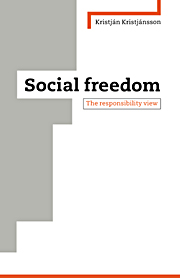Book contents
- Frontmatter
- Contents
- Acknowledgements
- 1 Introduction: freedom from Berlin onwards
- 2 Negative freedom: the nature of constraints
- 3 Obstacles and their weight
- 4 The test of moral responsibility
- 5 Internal bars and positive liberty
- 6 Freedom and power
- 7 Observations on method
- 8 Concluding remarks
- Bibliography
- Index
5 - Internal bars and positive liberty
Published online by Cambridge University Press: 31 March 2010
- Frontmatter
- Contents
- Acknowledgements
- 1 Introduction: freedom from Berlin onwards
- 2 Negative freedom: the nature of constraints
- 3 Obstacles and their weight
- 4 The test of moral responsibility
- 5 Internal bars and positive liberty
- 6 Freedom and power
- 7 Observations on method
- 8 Concluding remarks
- Bibliography
- Index
Summary
In chapter 1, objections were levelled against the thesis of the conceptual equivalence of negative and positive liberty. Then, in chapter 2, a ‘responsibility view’ emerged as the most promising variant of a negative-liberty theory. After developing such a view further in chapters 3–4, it is now time to ask how it stands up to the challenge of positive-liberty accounts, for which conceptual superiority is claimed by their advocates. The aim of the present chapter is to answer this question.
It should be recognised at the start that the term ‘positive liberty’ has often been used in a rather amorphous sense in the literature, covering a wide range of accounts and ideals that divide positive libertarians in many ways from one another as well as from negative libertarians. Berlin argues that the notion of positive liberty has historically assumed two distinct forms, the point of the first being self-abnegation (or what he calls the ‘return to the inner citadel’), and of the second self-realisation. However, it must be said that, notwithstanding Berlin's renowned lucidity of style, he uses a rather disconcerting variety of expressions and metaphors in his exegesis of the essence of positive theories. As I understand him, Berlin takes both these forms to involve a bifurcation of the self: the ‘higher’ self being, in the self-abnegation model, that which is immune from physical determination and, in the self-realisation model, the rational self that I am supposed to identify with and actualise.
- Type
- Chapter
- Information
- Social FreedomThe Responsibility View, pp. 94 - 143Publisher: Cambridge University PressPrint publication year: 1996



